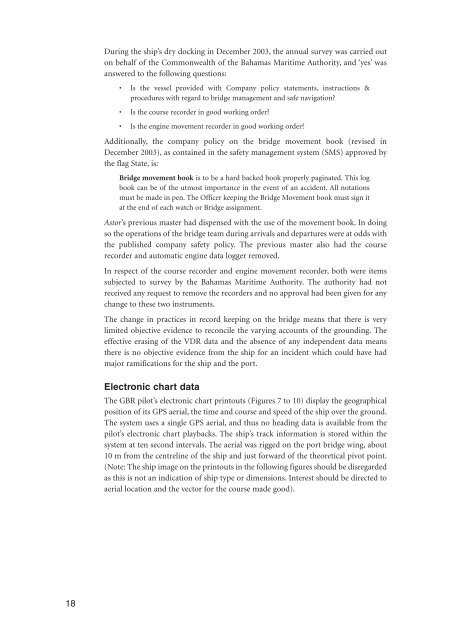MARINE SAFETY INVESTIGATION REPORT No. 200
MARINE SAFETY INVESTIGATION REPORT No. 200
MARINE SAFETY INVESTIGATION REPORT No. 200
You also want an ePaper? Increase the reach of your titles
YUMPU automatically turns print PDFs into web optimized ePapers that Google loves.
18<br />
During the ship’s dry docking in December <strong>200</strong>3, the annual survey was carried out<br />
on behalf of the Commonwealth of the Bahamas Maritime Authority, and ‘yes’ was<br />
answered to the following questions:<br />
• Is the vessel provided with Company policy statements, instructions &<br />
procedures with regard to bridge management and safe navigation?<br />
• Is the course recorder in good working order?<br />
• Is the engine movement recorder in good working order?<br />
Additionally, the company policy on the bridge movement book (revised in<br />
December <strong>200</strong>3), as contained in the safety management system (SMS) approved by<br />
the flag State, is:<br />
Bridge movement book is to be a hard backed book properly paginated. This log<br />
book can be of the utmost importance in the event of an accident. All notations<br />
must be made in pen. The Officer keeping the Bridge Movement book must sign it<br />
at the end of each watch or Bridge assignment.<br />
Astor’s previous master had dispensed with the use of the movement book. In doing<br />
so the operations of the bridge team during arrivals and departures were at odds with<br />
the published company safety policy. The previous master also had the course<br />
recorder and automatic engine data logger removed.<br />
In respect of the course recorder and engine movement recorder, both were items<br />
subjected to survey by the Bahamas Maritime Authority. The authority had not<br />
received any request to remove the recorders and no approval had been given for any<br />
change to these two instruments.<br />
The change in practices in record keeping on the bridge means that there is very<br />
limited objective evidence to reconcile the varying accounts of the grounding. The<br />
effective erasing of the VDR data and the absence of any independent data means<br />
there is no objective evidence from the ship for an incident which could have had<br />
major ramifications for the ship and the port.<br />
Electronic chart data<br />
The GBR pilot’s electronic chart printouts (Figures 7 to 10) display the geographical<br />
position of its GPS aerial, the time and course and speed of the ship over the ground.<br />
The system uses a single GPS aerial, and thus no heading data is available from the<br />
pilot’s electronic chart playbacks. The ship’s track information is stored within the<br />
system at ten second intervals. The aerial was rigged on the port bridge wing, about<br />
10 m from the centreline of the ship and just forward of the theoretical pivot point.<br />
(<strong>No</strong>te: The ship image on the printouts in the following figures should be disregarded<br />
as this is not an indication of ship type or dimensions. Interest should be directed to<br />
aerial location and the vector for the course made good).
















